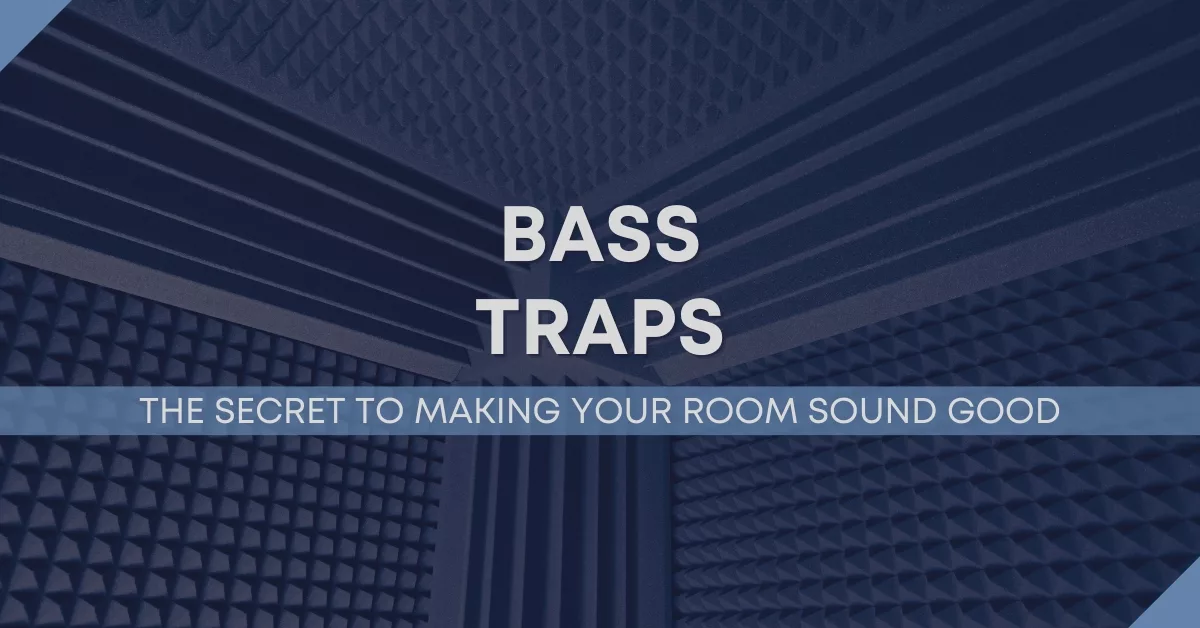
Whether you’re shooting a video or mixing music, you know that the slightest acoustic disturbance around you can affect the final product.
While a perfect studio doesn’t exist, you want the surrounding environment to help you produce the cleanest possible sound.
If that’s the case, you might want to look at bass traps. They’re effective, versatile, and will surprise you with the results.
If you’re not sure how they work or what to get, we’ll tell you everything you need to know so you can build your dream studio.
Bass traps are absorbers that reduce the amount of low-frequency energy in your room and balance out the bass response for a more consistent sound.
Generally, they use friction to resist air motion in sound energy, which enables them to convert sound into heat.
There are two types of bass traps, each with its own pros and cons: Porous absorbers and resonant absorbers.

Whether it’s acoustic foam, mineral wool, or fiberglass, porous absorbers can be manufactured from various materials as long as they’re thick enough.
Capable of absorbing frequencies equally throughout space, porous absorbers help maintain a natural sound balance.
The biggest downside is that they work better with mid and high-frequency energy. You’d have to get really thick ones to work with low frequencies.

Think of resonant absorbers as the opposite of porous absorbers. While porous absorbers are more effective with mid and high frequencies, resonant absorbers target specific low frequencies.
There are two types of resonant absorbers: Diaphragmatic and Helmholtz absorbers.
Diaphragmatic resonant absorbers use a membrane to neutralize bass frequencies. Helmholtz absorbers, on the other hand, neutralize frequencies using small openings in a tight cavity.
Related Article: How To Set Up A Home Recording Studio For Beginners
Yes, they do. If you want a clean sound in your room, bass traps are a no-brainer. They do more than absorb frequencies, though.
Bass traps can regulate room modes, which are resonances that cause sound distortion in your room, making music and movies sound weird.
Furthermore, a bass trap regulates flutter echoes, which occur when sound waves reflect off two parallel walls and hit each other.
The collision produces a pitch that changes your perception of sound. Bass traps can redirect these waves, preventing them from hitting each other.
Installing bass traps in your room doesn’t guarantee efficient frequency absorption. It depends on where you place them.
Porous absorbers work best when you space them a few inches away from a wall or a reflective surface (one-quarter wavelength to be specific).
Because air motion is at its fastest quarter of a wavelength away from walls or reflective surfaces, absorbers could generate more friction, converting sound to heat easier.
It’s better to place resonant absorbers in the corners of your walls. The trihedral or dihedral corners are where sound velocity is at its highest.
Now that you understand the mechanisms behind bass traps, it’s time to make the purchase. Fortunately, bass traps come with a wide range of prices. So, if you're on a budget, you can still find a suitable option.
Whether you’re setting up a podcast studio or a vocal booth, you’ll get a clean audio experience with SODOCT’s bass traps.
Not only do the high-density traps absorb low-end frequencies, but they also eliminate standing waves, giving you a more accurate perception of sound.
What sets these traps apart is that they’re SGS-approved. As a world-famous inspection organization, SGS is a global standard in quality. So, you know these traps will do their job well.
Not only that, SODOCT’s traps are made up of non-flammable materials, scoring a B1 grade in fire resistance. While they’re not the most fire-resistant traps on the market, you won’t have to worry about them catching fire.
When you open your package, you’ll notice that the traps are squashed. Don’t worry. It’s intentional.
Leave them a day or two, and they’ll pop back up.
While these traps offer great value, they’re not without cons. For starters, they don’t come with adhesive tape. You have to buy one yourself.
For the most part, you won’t have to worry about the traps’ compression in the box. However, keep in mind that some of them may not fully expand when you take them out.
The biggest disadvantage to these traps is that they’re a bit thin, although that doesn’t prevent them from doing a solid job. Still, if you’re looking for THICK bass traps, you might want to look elsewhere.
From playing music to giving lectures to enjoying the score of a good movie, Arrowzoom bass traps have got you covered.
These traps are quite versatile, offering both low frequency and broadband absorption. The high-quality foam reduces the echo in your room (especially in the corners) and increases the audio quality for an accurate perception of sound.
Combine these with foam cubes, and you can even eliminate standing waves outside your room.
While electronic gadgets with plastic components can easily catch fire, Arrowzoom has made sure to stay on top of its game by making them fireproof. Not only that, you don’t have to worry about inhalation toxicity, as they’re made of environment-friendly materials.
Unlike SODOCT’s traps, these won’t need 24h+ to expand. Pro tip: Let them sit in a bathtub full of water for 30-60 minutes. Take them out, wring them gently, and let them dry. That’ll help them expand faster.
With detailed cutting, great elasticity, and an easy-to-clean design, Arrowzoom bass traps offer great value for money.
Not only do you not get adhesive tape in the package, but the traps are also not easy to install. They’re also quite small, so they work better in smaller rooms. Otherwise, you might have to buy more of them to notice a big difference in sound quality.
Are you sick of the dull black color that most traps come in? Well, SoundAssured decided to spice things up with a colorful collection so you can make your room stand out and have more character.
Whether it’s annoying reverberations or unwanted echoes, SoundAssured bass traps will eliminate any pesky sounds so you can get a high-quality, clean audio experience.
These bass traps have been tested by Riverbank acoustical labs, a leading organization that specializes in testing sound equipment.
When it comes to their design, these bass traps have several advantages. Did you think SODOCT’s B1-graded traps were impressive? SoundAssured’s traps scored an A1 grade in the ASTM E-84 test, the standard method of testing an object’s fire resistance.
Unlike Arrowzoom’s traps, these bass traps are quite large, which gives you the luxury of being economical with how many of them to use.
If you don’t like your traps compressed in the box, you have the option to choose uncompressed packaging. In that case, though, you’re limited to the 2-pack.
It’s more of an aesthetics issue than a technical one. The color of your traps might come in different grades. If you’re not nit-picky, it’s not going to be a problem.
While it looks a bit underwhelming, you shouldn’t underestimate Primacoustic’s high-density tri-corner bass trap.
The glass wool material effectively traps air between its glass fibers, giving the bass traps their insulation abilities.
Their developers put a lot of thought into the design. Since you place them on the point where your walls meet the ceiling or the floor, they’d be more effective at absorbing frequencies, as that’s where sound is at its fastest.
They’re on the smaller side, so it’s better to use them in smaller rooms. If you have a big room, you can buy multiple traps to compensate for the small size.
Despite being effective frequency absorbers, they’re quite pricey for what they offer.
As the final product on this list, Auralex Acoustics’s bass traps end it with a bang.
Large in size and dense in volume, with accurate cuts, these bass traps will get the job done. Auralex is all about practicality. They don’t compress their traps in the box. So, you won’t have to waste time waiting for them to expand.
They also come in different colors to keep things fresh.
While they absorb frequencies effectively, these bass traps are on the pricier side.
Related Article: How To Reduce The Noise Floor in Your Recordings
You might be wondering: Why would I build bass traps when I can order them online? Because they’re cheap and easy to make. Now, let’s get to business.
Here’s what you’ll need:
The idea behind a DIY bass trap is to build a frame around the fiberglass. So, cut two feet of steel from your steel studs. Then, measure the remaining 10 feet so that the stud is two feet wide and four feet long.
Cut two triangle-shaped pieces of metal out so that you can fold the stud into a U shape. Now the hard part is over.
All you have to do now is slide your fiberglass into the steel frame. Pro tip: Check if your steel is deep enough to fit more than one fiberglass piece.
Close the bottom of the frame with the two feet piece of steel you cut at the beginning. Drill holes on all four corners of the frame and instill the rivets with the rivet gun to keep them together.
Now all that’s left is to wrap the cloth around the frame and pull it tight. Glew the cloth to the frame wherever you see fit.
Et voila!
Now you know what bass traps are and how they work. If you want to install bass traps in your room, you need to determine the type of frequency you want to absorb.
Fortunately, you have a wide range of traps to choose from, all with various characteristics and prices. If it comes down to it, you can even make a bass trap yourself.
So, nothing can stop you from making your room sound better.
If you found the information in this article helpful, please consider subscribing to our blog for more acoustical tips, tricks, and advice!
"Some of the links within this article are affiliate links. These links are from various companies such as Amazon. This means if you click on any of these links and purchase the item or service, I will receive an affiliate commission. This is at no cost to you and the money gets invested back into Audio Sorcerer LLC."